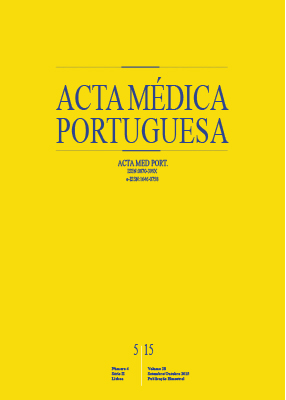Current Clinical Indications for Small Bowel Capsule Endoscopy
DOI:
https://doi.org/10.20344/amp.6128Keywords:
Capsule Endoscopy, Intestinal Diseases.Abstract
Introduction: Small bowel capsule endoscopy is currently the first line diagnostic examination for many diseases affecting the small bowel. This article aims to review and critically address the current indications of small bowel capsule endoscopy in clinical practice.
Material and Methods: Bibliographic review of relevant and recent papers indexed in PubMed.
Results and Discussion: Small bowel capsule endoscopy enables a non-invasive full-assessment of the small bowel mucosa, with high diagnostic yield even for subtle lesions. In patients with obscure gastrointestinal bleeding, diagnostic yield is higher when performed early after the onset of bleeding. Endoscopic treatment of angioectasias using balloon-assisted enteroscopy may contribute to reduce rebleeding, while the risk of rebleeding in patients with “negative“ small bowel capsule endoscopy is debatable. Cross-sectional imaging
may be more accurate than small bowel capsule endoscopy for the diagnosis of large small bowel tumors. The Smooth Protruding Index on Capsule Endoscopy (SPICE score) may help to differentiate submucosal tumors from innocent bulges. Small bowel capsule endoscopy is also a key diagnostic instrument in patients with suspected Crohn’s disease and non-diagnostic ileocolonoscopy; it may also influence prognosis and therapeutic management, by determining disease extent and activity in patients with known Crohn’s disease. The role of small bowel capsule endoscopy to investigate possible complications in patients with non-responsive coeliac
disease is evolving.
Conclusions: Small bowel capsule endoscopy is a valuable diagnostic instrument for patients with obscure gastrointestinal bleeding and/or suspected small bowel tumors; it may also be a key examination in patients with suspected Crohn’s disease, or patients with known Crohn’s disease to fully assess disease extension and activity; finally, it may contribute for the diagnosis of complications of non-responsive coeliac disease.
Downloads
Downloads
Published
How to Cite
Issue
Section
License
All the articles published in the AMP are open access and comply with the requirements of funding agencies or academic institutions. The AMP is governed by the terms of the Creative Commons ‘Attribution – Non-Commercial Use - (CC-BY-NC)’ license, regarding the use by third parties.
It is the author’s responsibility to obtain approval for the reproduction of figures, tables, etc. from other publications.
Upon acceptance of an article for publication, the authors will be asked to complete the ICMJE “Copyright Liability and Copyright Sharing Statement “(http://www.actamedicaportuguesa.com/info/AMP-NormasPublicacao.pdf) and the “Declaration of Potential Conflicts of Interest” (http:// www.icmje.org/conflicts-of-interest). An e-mail will be sent to the corresponding author to acknowledge receipt of the manuscript.
After publication, the authors are authorised to make their articles available in repositories of their institutions of origin, as long as they always mention where they were published and according to the Creative Commons license.









